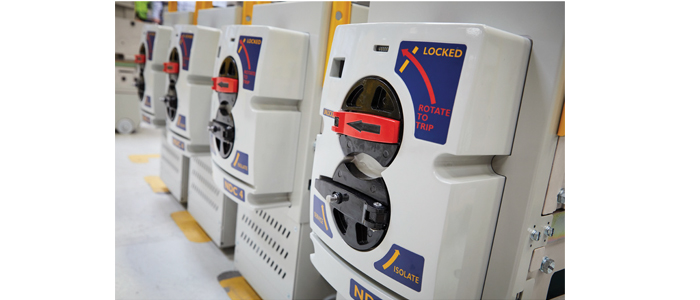- +61 7 3374 2877
- Email Us
PowerBond provides an innovative solution for safe isolations on DC electrified railways. Building on the success of SafeBond, PowerBond incorporates a unique busbar selector which connects the circuit breaker to the positive busbar or a negative/earth busbar.
This allows the contact line to be fed with power for normal rail operations or bonded to a safe potential to allow maintenance teams to work safely on or near the line.
There are many hazards associated with traditional short-circuiting methods, including working in close proximity to conductors with a hazardous voltage or working close to train movements. The standard EN 50488:2021 (“Railway applications — Fixed installations — Electrical protective measures for working on or near an overhead contact line system and/or its associated return circuit”) includes five steps to providing an isolation: disconnecting the supply, securing against reconnection, verifying the absence of operating voltage, carrying out our earthing or short-circuiting and providing protection against adjacent hazardous voltages.
Improve Safety and Maintenance Efficiency
The most significant advantage of PowerBond is that it can be used to improve safety and maintenance efficiency on the railway and so aid compliance with the requirements of EN 50488:2021. Electrical isolations may be initiated at the traction power control center, reducing the number of people who need to go to specific substations or trackside locations to perform switching and strapping duties. Options are available to interface with systems to provide remote securing to assure safe isolations are maintained.

The PowerBond busbar selector is mounted under the circuit breaker mechanism which forms parts of the withdrawable circuit breaker truck. The unique configuration of the busbar selector means that only one busbar is connected at any time. To further enhance safety, shutters automatically close to cover busbars which are not connected. Within the switchgear panel, the
internal segregation between the positive and negative/earth busbars reduces the likelihood of an internal arc fault between these two potentials.
The circuit breaker main contacts make and break all current flows through the PowerBond main circuit. This has the advantage of reducing the number of contacts which are subjected to arcing, which reduces the amount of maintenance required. The circuit breaker mechanism, main contacts and arc chute are based on the popular NDC circuit breaker, bringing to PowerBond the extensive railway service history of this successful DC circuit breaker. To ensure that the short-circuit is maintained if current flows through the unit, an interlock is provided that disables the direct acting overcurrent trip, and all electronic protection devices are disabled.
To further enhance the safety of switchgear maintenance teams, the transducers and associated equipment are mounted on the withdrawable truck. During maintenance activities on the switchgear, the circuit breaker is withdrawn from the panel and is isolated from hazardous traction voltages, assured by comprehensive interlocking between the circuit breaker truck and the switchgear panel. Routine maintenance and testing, such as injection testing for protection relays, can be performed safe in the knowledge that the equipment is only connected to auxiliary power supplies.